Organizational Behavior Report: Waitrose & Partners Analysis
VerifiedAdded on 2023/01/11
|15
|4808
|32
Report
AI Summary
This report provides an in-depth analysis of organizational behavior, using Waitrose & Partners as a case study. It explores how organizational culture, power dynamics, and politics influence individual and team behavior and performance. The report delves into content and process theories of motivation, including Maslow's hierarchy of needs and Vroom's expectancy theory, and discusses motivational techniques for achieving organizational goals. Furthermore, it examines the characteristics of effective and ineffective teams and their impact on organizational outcomes. Finally, the report addresses key concepts and philosophies of organizational behavior, offering insights for managers to navigate various workplace situations. The report provides a comprehensive overview of OB principles within the context of a real-world business environment.
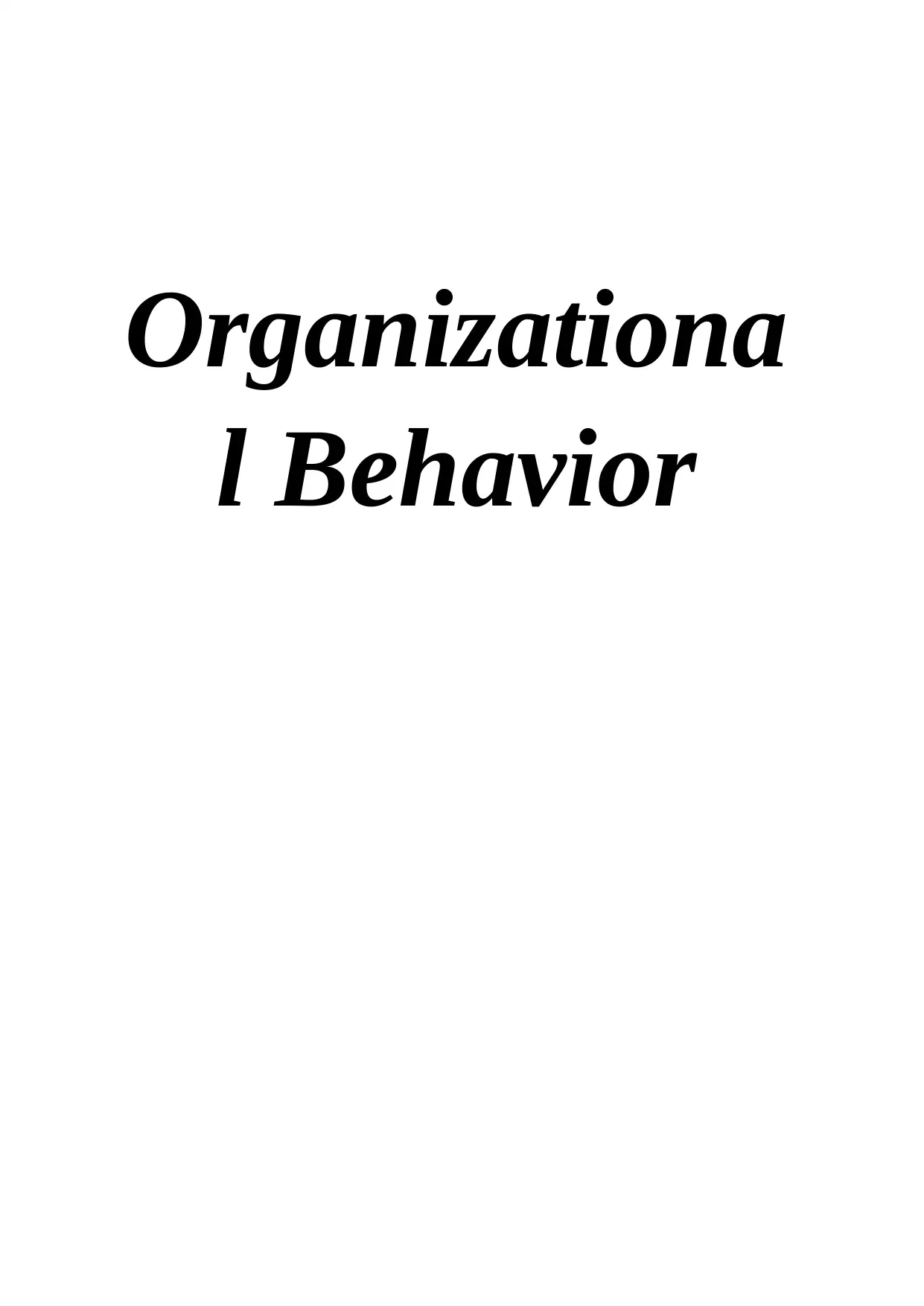
Organizationa
l Behavior
l Behavior
Paraphrase This Document
Need a fresh take? Get an instant paraphrase of this document with our AI Paraphraser
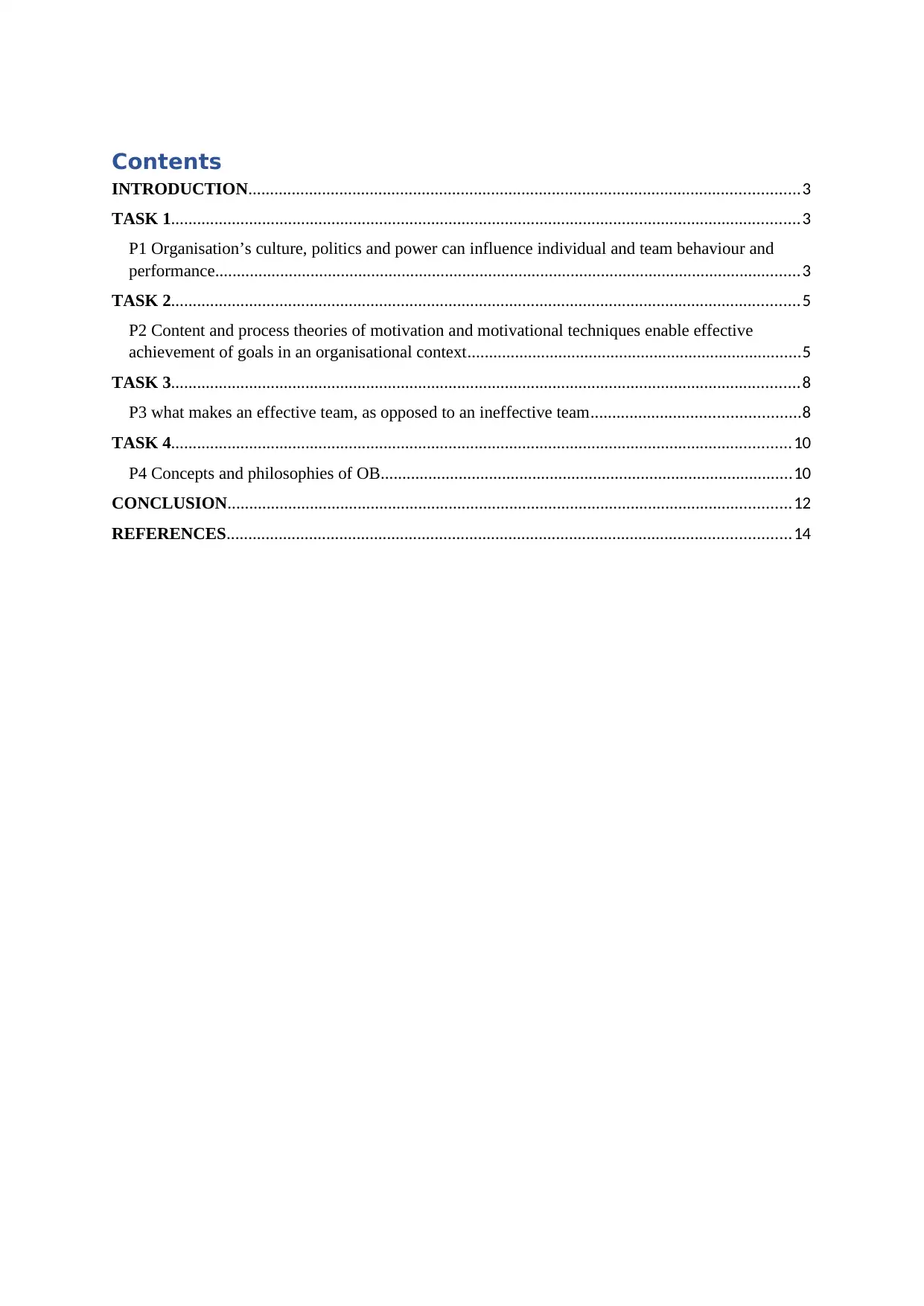
Contents
INTRODUCTION...............................................................................................................................3
TASK 1.................................................................................................................................................3
P1 Organisation’s culture, politics and power can influence individual and team behaviour and
performance.......................................................................................................................................3
TASK 2.................................................................................................................................................5
P2 Content and process theories of motivation and motivational techniques enable effective
achievement of goals in an organisational context.............................................................................5
TASK 3.................................................................................................................................................8
P3 what makes an effective team, as opposed to an ineffective team................................................8
TASK 4...............................................................................................................................................10
P4 Concepts and philosophies of OB...............................................................................................10
CONCLUSION..................................................................................................................................12
REFERENCES..................................................................................................................................14
INTRODUCTION...............................................................................................................................3
TASK 1.................................................................................................................................................3
P1 Organisation’s culture, politics and power can influence individual and team behaviour and
performance.......................................................................................................................................3
TASK 2.................................................................................................................................................5
P2 Content and process theories of motivation and motivational techniques enable effective
achievement of goals in an organisational context.............................................................................5
TASK 3.................................................................................................................................................8
P3 what makes an effective team, as opposed to an ineffective team................................................8
TASK 4...............................................................................................................................................10
P4 Concepts and philosophies of OB...............................................................................................10
CONCLUSION..................................................................................................................................12
REFERENCES..................................................................................................................................14
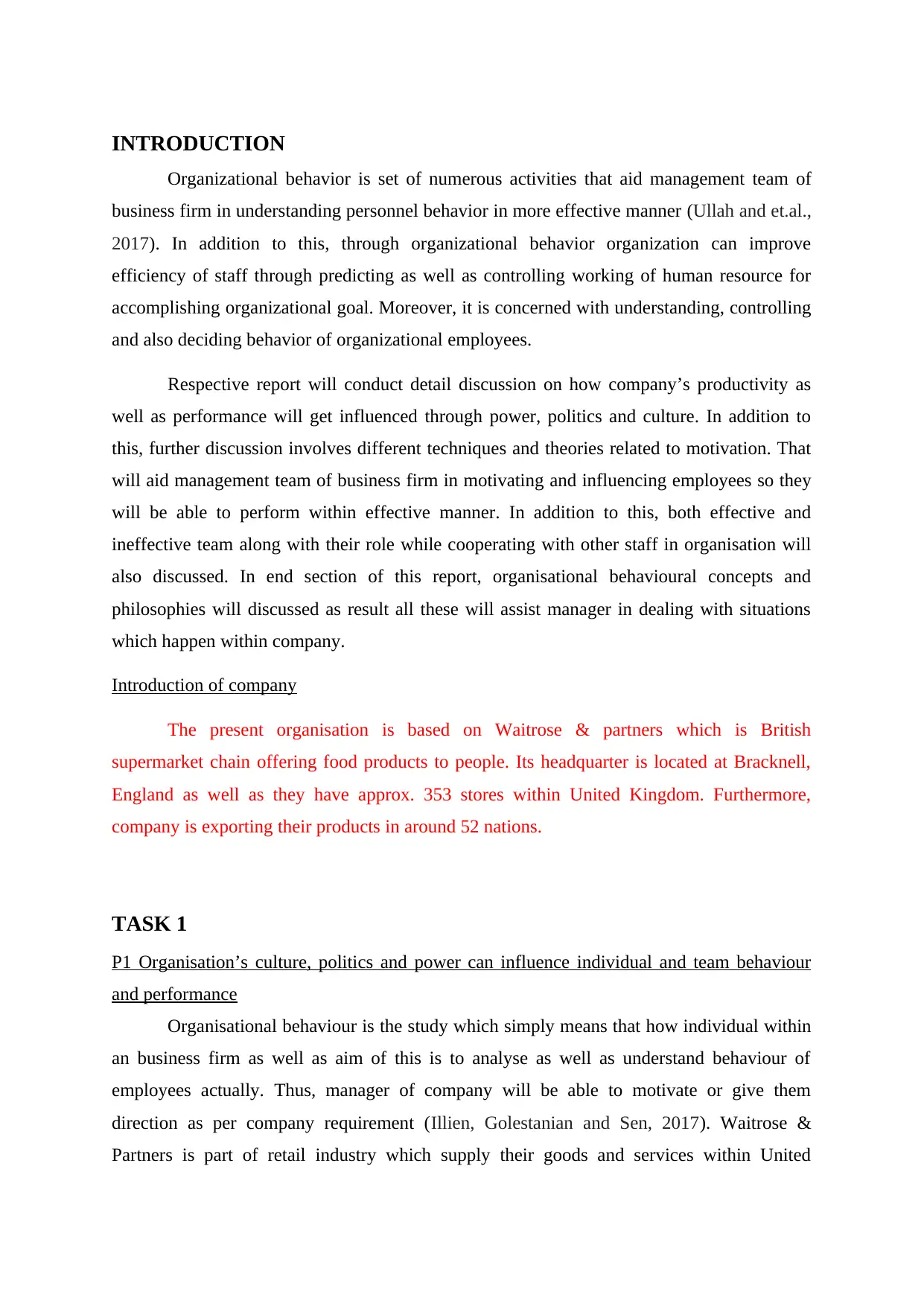
INTRODUCTION
Organizational behavior is set of numerous activities that aid management team of
business firm in understanding personnel behavior in more effective manner (Ullah and et.al.,
2017). In addition to this, through organizational behavior organization can improve
efficiency of staff through predicting as well as controlling working of human resource for
accomplishing organizational goal. Moreover, it is concerned with understanding, controlling
and also deciding behavior of organizational employees.
Respective report will conduct detail discussion on how company’s productivity as
well as performance will get influenced through power, politics and culture. In addition to
this, further discussion involves different techniques and theories related to motivation. That
will aid management team of business firm in motivating and influencing employees so they
will be able to perform within effective manner. In addition to this, both effective and
ineffective team along with their role while cooperating with other staff in organisation will
also discussed. In end section of this report, organisational behavioural concepts and
philosophies will discussed as result all these will assist manager in dealing with situations
which happen within company.
Introduction of company
The present organisation is based on Waitrose & partners which is British
supermarket chain offering food products to people. Its headquarter is located at Bracknell,
England as well as they have approx. 353 stores within United Kingdom. Furthermore,
company is exporting their products in around 52 nations.
TASK 1
P1 Organisation’s culture, politics and power can influence individual and team behaviour
and performance
Organisational behaviour is the study which simply means that how individual within
an business firm as well as aim of this is to analyse as well as understand behaviour of
employees actually. Thus, manager of company will be able to motivate or give them
direction as per company requirement (Illien, Golestanian and Sen, 2017). Waitrose &
Partners is part of retail industry which supply their goods and services within United
Organizational behavior is set of numerous activities that aid management team of
business firm in understanding personnel behavior in more effective manner (Ullah and et.al.,
2017). In addition to this, through organizational behavior organization can improve
efficiency of staff through predicting as well as controlling working of human resource for
accomplishing organizational goal. Moreover, it is concerned with understanding, controlling
and also deciding behavior of organizational employees.
Respective report will conduct detail discussion on how company’s productivity as
well as performance will get influenced through power, politics and culture. In addition to
this, further discussion involves different techniques and theories related to motivation. That
will aid management team of business firm in motivating and influencing employees so they
will be able to perform within effective manner. In addition to this, both effective and
ineffective team along with their role while cooperating with other staff in organisation will
also discussed. In end section of this report, organisational behavioural concepts and
philosophies will discussed as result all these will assist manager in dealing with situations
which happen within company.
Introduction of company
The present organisation is based on Waitrose & partners which is British
supermarket chain offering food products to people. Its headquarter is located at Bracknell,
England as well as they have approx. 353 stores within United Kingdom. Furthermore,
company is exporting their products in around 52 nations.
TASK 1
P1 Organisation’s culture, politics and power can influence individual and team behaviour
and performance
Organisational behaviour is the study which simply means that how individual within
an business firm as well as aim of this is to analyse as well as understand behaviour of
employees actually. Thus, manager of company will be able to motivate or give them
direction as per company requirement (Illien, Golestanian and Sen, 2017). Waitrose &
Partners is part of retail industry which supply their goods and services within United
⊘ This is a preview!⊘
Do you want full access?
Subscribe today to unlock all pages.

Trusted by 1+ million students worldwide
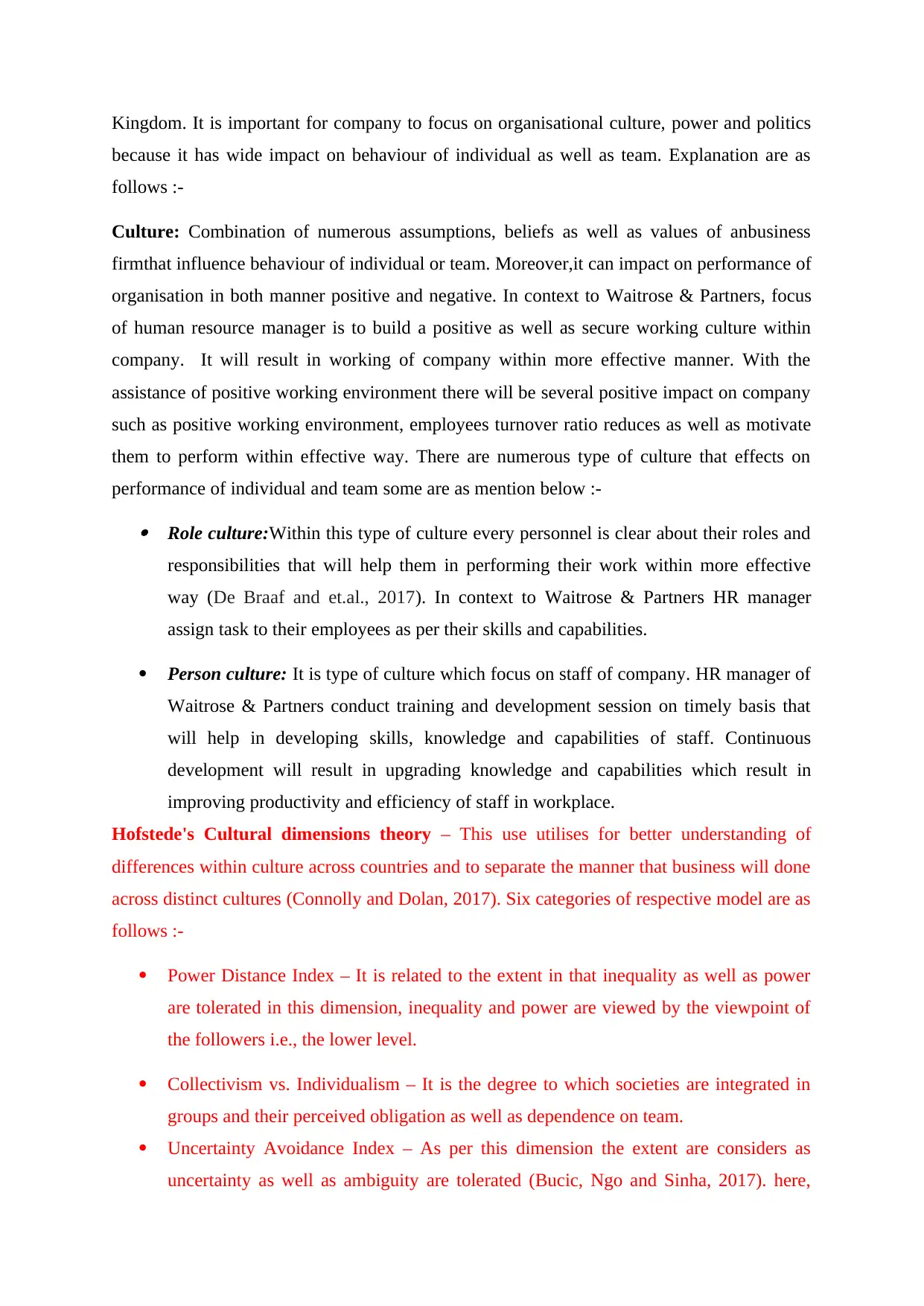
Kingdom. It is important for company to focus on organisational culture, power and politics
because it has wide impact on behaviour of individual as well as team. Explanation are as
follows :-
Culture: Combination of numerous assumptions, beliefs as well as values of anbusiness
firmthat influence behaviour of individual or team. Moreover,it can impact on performance of
organisation in both manner positive and negative. In context to Waitrose & Partners, focus
of human resource manager is to build a positive as well as secure working culture within
company. It will result in working of company within more effective manner. With the
assistance of positive working environment there will be several positive impact on company
such as positive working environment, employees turnover ratio reduces as well as motivate
them to perform within effective way. There are numerous type of culture that effects on
performance of individual and team some are as mention below :- Role culture:Within this type of culture every personnel is clear about their roles and
responsibilities that will help them in performing their work within more effective
way (De Braaf and et.al., 2017). In context to Waitrose & Partners HR manager
assign task to their employees as per their skills and capabilities.
Person culture: It is type of culture which focus on staff of company. HR manager of
Waitrose & Partners conduct training and development session on timely basis that
will help in developing skills, knowledge and capabilities of staff. Continuous
development will result in upgrading knowledge and capabilities which result in
improving productivity and efficiency of staff in workplace.
Hofstede's Cultural dimensions theory – This use utilises for better understanding of
differences within culture across countries and to separate the manner that business will done
across distinct cultures (Connolly and Dolan, 2017). Six categories of respective model are as
follows :-
Power Distance Index – It is related to the extent in that inequality as well as power
are tolerated in this dimension, inequality and power are viewed by the viewpoint of
the followers i.e., the lower level.
Collectivism vs. Individualism – It is the degree to which societies are integrated in
groups and their perceived obligation as well as dependence on team.
Uncertainty Avoidance Index – As per this dimension the extent are considers as
uncertainty as well as ambiguity are tolerated (Bucic, Ngo and Sinha, 2017). here,
because it has wide impact on behaviour of individual as well as team. Explanation are as
follows :-
Culture: Combination of numerous assumptions, beliefs as well as values of anbusiness
firmthat influence behaviour of individual or team. Moreover,it can impact on performance of
organisation in both manner positive and negative. In context to Waitrose & Partners, focus
of human resource manager is to build a positive as well as secure working culture within
company. It will result in working of company within more effective manner. With the
assistance of positive working environment there will be several positive impact on company
such as positive working environment, employees turnover ratio reduces as well as motivate
them to perform within effective way. There are numerous type of culture that effects on
performance of individual and team some are as mention below :- Role culture:Within this type of culture every personnel is clear about their roles and
responsibilities that will help them in performing their work within more effective
way (De Braaf and et.al., 2017). In context to Waitrose & Partners HR manager
assign task to their employees as per their skills and capabilities.
Person culture: It is type of culture which focus on staff of company. HR manager of
Waitrose & Partners conduct training and development session on timely basis that
will help in developing skills, knowledge and capabilities of staff. Continuous
development will result in upgrading knowledge and capabilities which result in
improving productivity and efficiency of staff in workplace.
Hofstede's Cultural dimensions theory – This use utilises for better understanding of
differences within culture across countries and to separate the manner that business will done
across distinct cultures (Connolly and Dolan, 2017). Six categories of respective model are as
follows :-
Power Distance Index – It is related to the extent in that inequality as well as power
are tolerated in this dimension, inequality and power are viewed by the viewpoint of
the followers i.e., the lower level.
Collectivism vs. Individualism – It is the degree to which societies are integrated in
groups and their perceived obligation as well as dependence on team.
Uncertainty Avoidance Index – As per this dimension the extent are considers as
uncertainty as well as ambiguity are tolerated (Bucic, Ngo and Sinha, 2017). here,
Paraphrase This Document
Need a fresh take? Get an instant paraphrase of this document with our AI Paraphraser
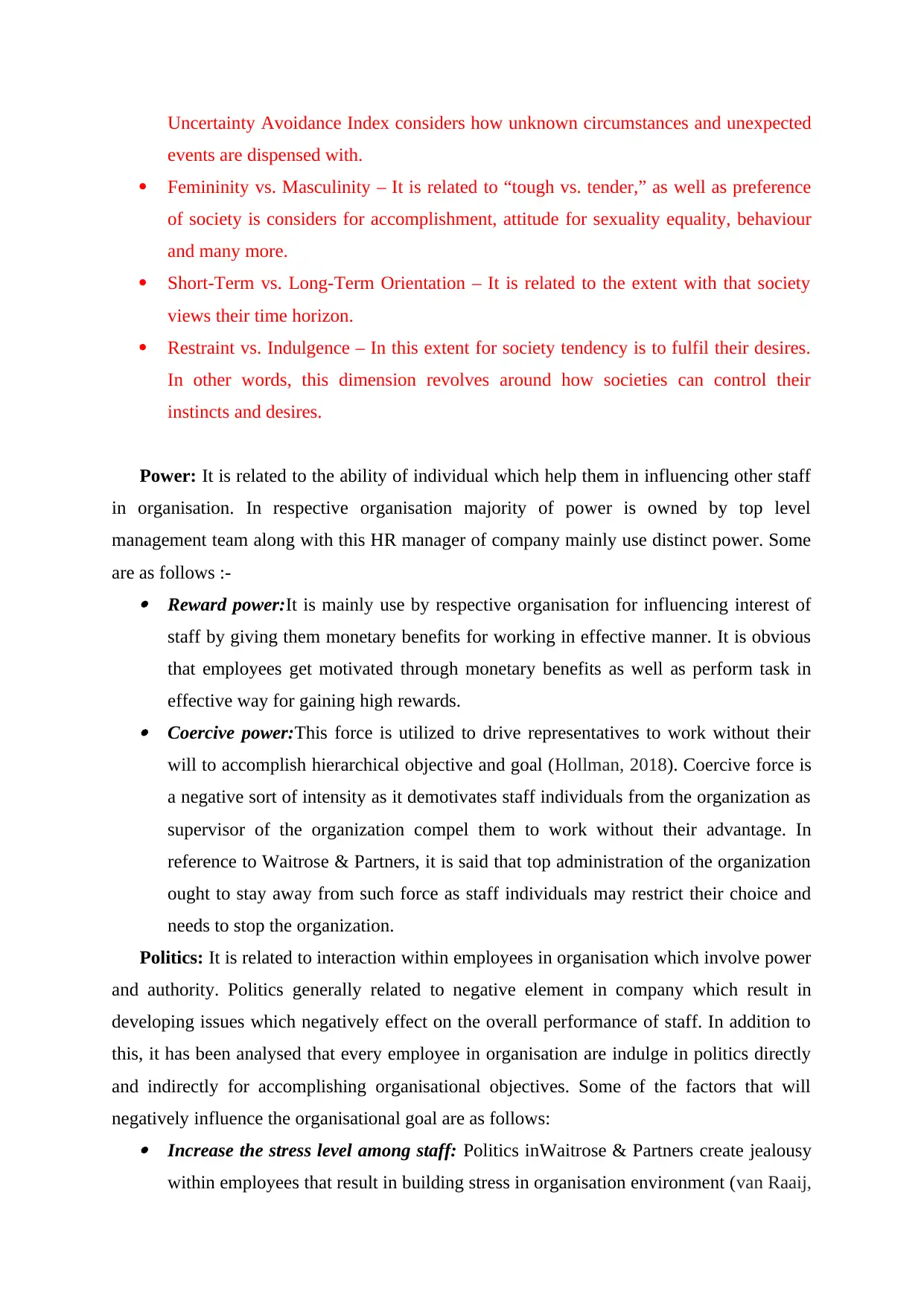
Uncertainty Avoidance Index considers how unknown circumstances and unexpected
events are dispensed with.
Femininity vs. Masculinity – It is related to “tough vs. tender,” as well as preference
of society is considers for accomplishment, attitude for sexuality equality, behaviour
and many more.
Short-Term vs. Long-Term Orientation – It is related to the extent with that society
views their time horizon.
Restraint vs. Indulgence – In this extent for society tendency is to fulfil their desires.
In other words, this dimension revolves around how societies can control their
instincts and desires.
Power: It is related to the ability of individual which help them in influencing other staff
in organisation. In respective organisation majority of power is owned by top level
management team along with this HR manager of company mainly use distinct power. Some
are as follows :- Reward power:It is mainly use by respective organisation for influencing interest of
staff by giving them monetary benefits for working in effective manner. It is obvious
that employees get motivated through monetary benefits as well as perform task in
effective way for gaining high rewards. Coercive power:This force is utilized to drive representatives to work without their
will to accomplish hierarchical objective and goal (Hollman, 2018). Coercive force is
a negative sort of intensity as it demotivates staff individuals from the organization as
supervisor of the organization compel them to work without their advantage. In
reference to Waitrose & Partners, it is said that top administration of the organization
ought to stay away from such force as staff individuals may restrict their choice and
needs to stop the organization.
Politics: It is related to interaction within employees in organisation which involve power
and authority. Politics generally related to negative element in company which result in
developing issues which negatively effect on the overall performance of staff. In addition to
this, it has been analysed that every employee in organisation are indulge in politics directly
and indirectly for accomplishing organisational objectives. Some of the factors that will
negatively influence the organisational goal are as follows: Increase the stress level among staff: Politics inWaitrose & Partners create jealousy
within employees that result in building stress in organisation environment (van Raaij,
events are dispensed with.
Femininity vs. Masculinity – It is related to “tough vs. tender,” as well as preference
of society is considers for accomplishment, attitude for sexuality equality, behaviour
and many more.
Short-Term vs. Long-Term Orientation – It is related to the extent with that society
views their time horizon.
Restraint vs. Indulgence – In this extent for society tendency is to fulfil their desires.
In other words, this dimension revolves around how societies can control their
instincts and desires.
Power: It is related to the ability of individual which help them in influencing other staff
in organisation. In respective organisation majority of power is owned by top level
management team along with this HR manager of company mainly use distinct power. Some
are as follows :- Reward power:It is mainly use by respective organisation for influencing interest of
staff by giving them monetary benefits for working in effective manner. It is obvious
that employees get motivated through monetary benefits as well as perform task in
effective way for gaining high rewards. Coercive power:This force is utilized to drive representatives to work without their
will to accomplish hierarchical objective and goal (Hollman, 2018). Coercive force is
a negative sort of intensity as it demotivates staff individuals from the organization as
supervisor of the organization compel them to work without their advantage. In
reference to Waitrose & Partners, it is said that top administration of the organization
ought to stay away from such force as staff individuals may restrict their choice and
needs to stop the organization.
Politics: It is related to interaction within employees in organisation which involve power
and authority. Politics generally related to negative element in company which result in
developing issues which negatively effect on the overall performance of staff. In addition to
this, it has been analysed that every employee in organisation are indulge in politics directly
and indirectly for accomplishing organisational objectives. Some of the factors that will
negatively influence the organisational goal are as follows: Increase the stress level among staff: Politics inWaitrose & Partners create jealousy
within employees that result in building stress in organisation environment (van Raaij,
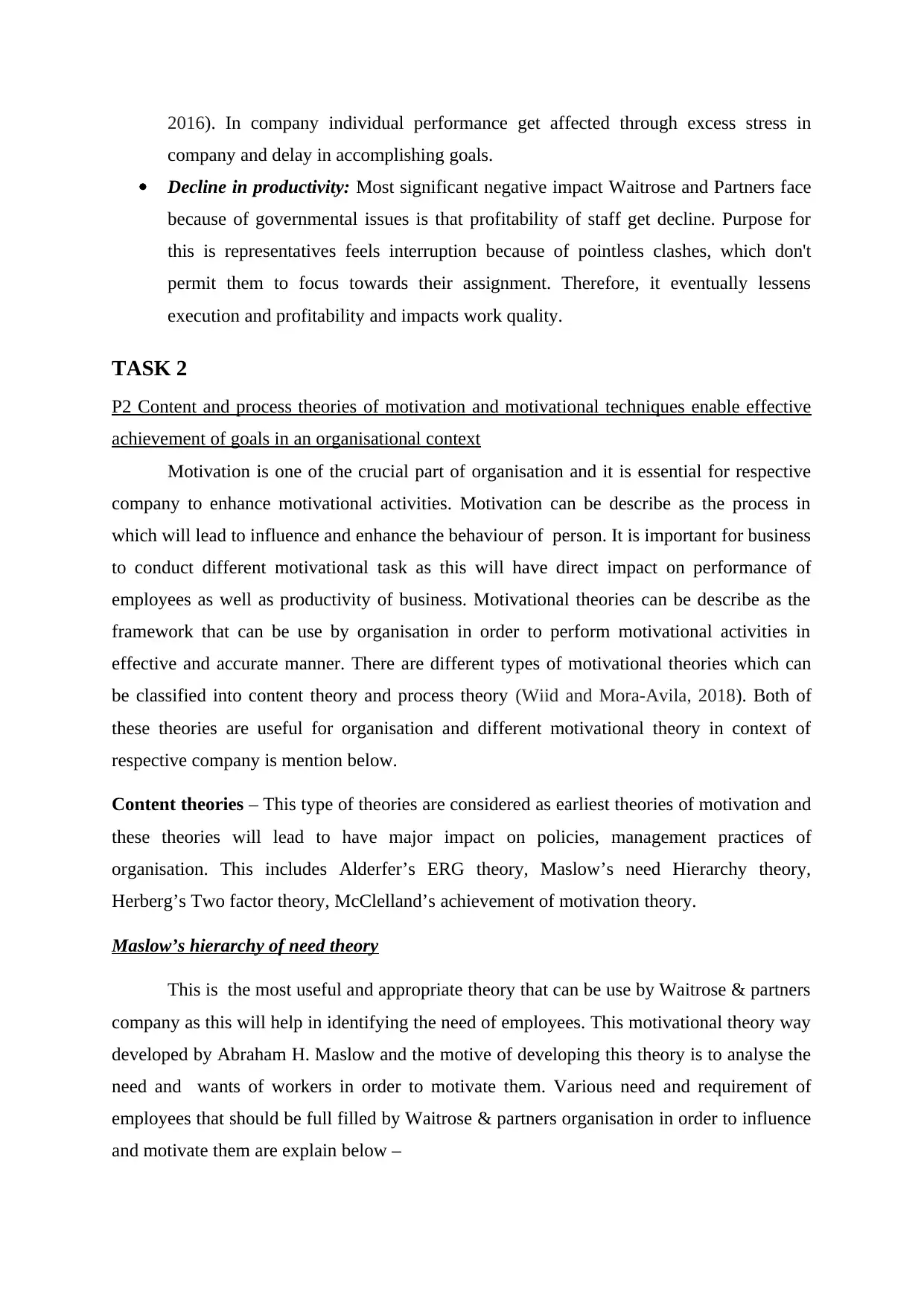
2016). In company individual performance get affected through excess stress in
company and delay in accomplishing goals.
Decline in productivity: Most significant negative impact Waitrose and Partners face
because of governmental issues is that profitability of staff get decline. Purpose for
this is representatives feels interruption because of pointless clashes, which don't
permit them to focus towards their assignment. Therefore, it eventually lessens
execution and profitability and impacts work quality.
TASK 2
P2 Content and process theories of motivation and motivational techniques enable effective
achievement of goals in an organisational context
Motivation is one of the crucial part of organisation and it is essential for respective
company to enhance motivational activities. Motivation can be describe as the process in
which will lead to influence and enhance the behaviour of person. It is important for business
to conduct different motivational task as this will have direct impact on performance of
employees as well as productivity of business. Motivational theories can be describe as the
framework that can be use by organisation in order to perform motivational activities in
effective and accurate manner. There are different types of motivational theories which can
be classified into content theory and process theory (Wiid and Mora‐Avila, 2018). Both of
these theories are useful for organisation and different motivational theory in context of
respective company is mention below.
Content theories – This type of theories are considered as earliest theories of motivation and
these theories will lead to have major impact on policies, management practices of
organisation. This includes Alderfer’s ERG theory, Maslow’s need Hierarchy theory,
Herberg’s Two factor theory, McClelland’s achievement of motivation theory.
Maslow’s hierarchy of need theory
This is the most useful and appropriate theory that can be use by Waitrose & partners
company as this will help in identifying the need of employees. This motivational theory way
developed by Abraham H. Maslow and the motive of developing this theory is to analyse the
need and wants of workers in order to motivate them. Various need and requirement of
employees that should be full filled by Waitrose & partners organisation in order to influence
and motivate them are explain below –
company and delay in accomplishing goals.
Decline in productivity: Most significant negative impact Waitrose and Partners face
because of governmental issues is that profitability of staff get decline. Purpose for
this is representatives feels interruption because of pointless clashes, which don't
permit them to focus towards their assignment. Therefore, it eventually lessens
execution and profitability and impacts work quality.
TASK 2
P2 Content and process theories of motivation and motivational techniques enable effective
achievement of goals in an organisational context
Motivation is one of the crucial part of organisation and it is essential for respective
company to enhance motivational activities. Motivation can be describe as the process in
which will lead to influence and enhance the behaviour of person. It is important for business
to conduct different motivational task as this will have direct impact on performance of
employees as well as productivity of business. Motivational theories can be describe as the
framework that can be use by organisation in order to perform motivational activities in
effective and accurate manner. There are different types of motivational theories which can
be classified into content theory and process theory (Wiid and Mora‐Avila, 2018). Both of
these theories are useful for organisation and different motivational theory in context of
respective company is mention below.
Content theories – This type of theories are considered as earliest theories of motivation and
these theories will lead to have major impact on policies, management practices of
organisation. This includes Alderfer’s ERG theory, Maslow’s need Hierarchy theory,
Herberg’s Two factor theory, McClelland’s achievement of motivation theory.
Maslow’s hierarchy of need theory
This is the most useful and appropriate theory that can be use by Waitrose & partners
company as this will help in identifying the need of employees. This motivational theory way
developed by Abraham H. Maslow and the motive of developing this theory is to analyse the
need and wants of workers in order to motivate them. Various need and requirement of
employees that should be full filled by Waitrose & partners organisation in order to influence
and motivate them are explain below –
⊘ This is a preview!⊘
Do you want full access?
Subscribe today to unlock all pages.

Trusted by 1+ million students worldwide
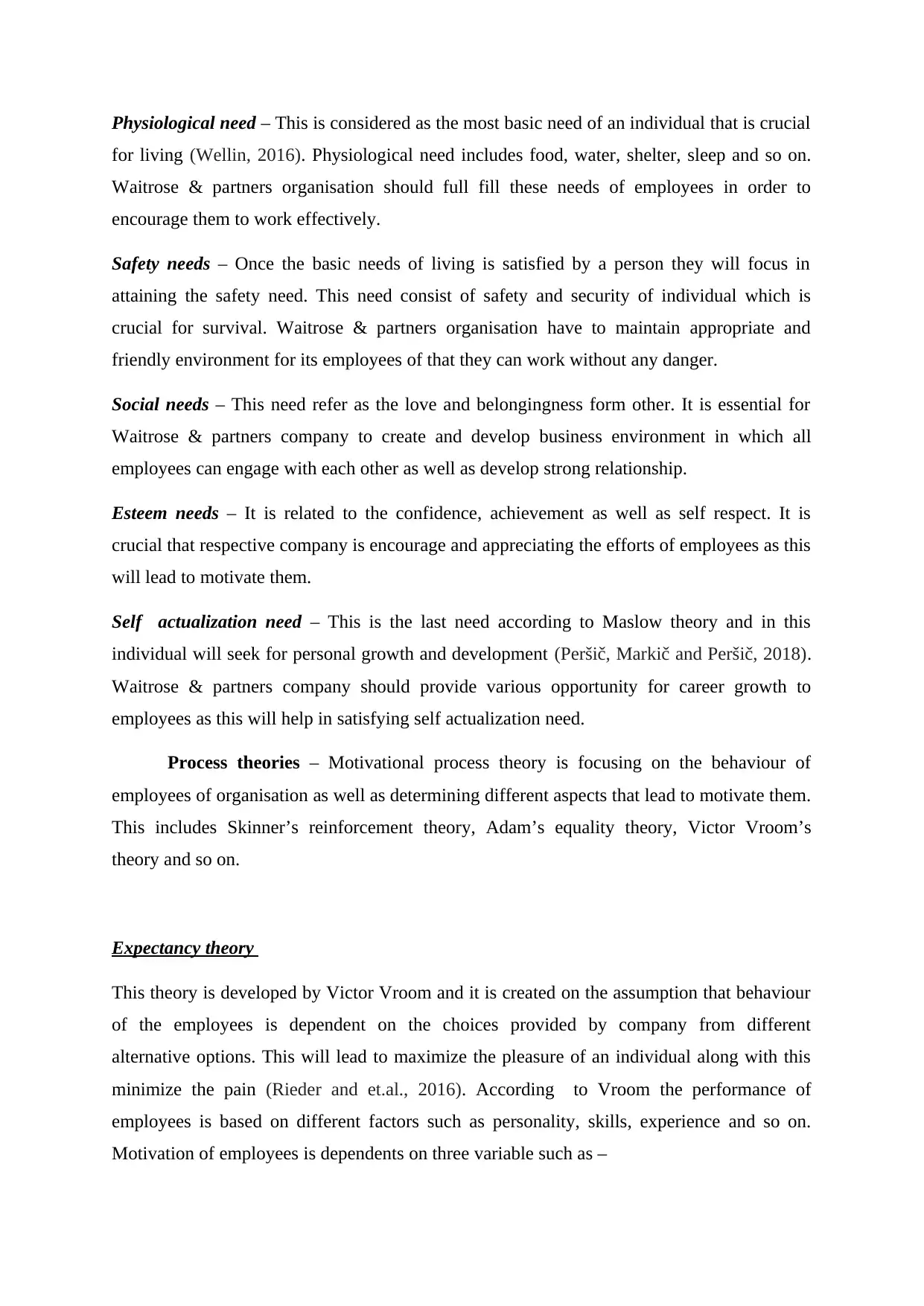
Physiological need – This is considered as the most basic need of an individual that is crucial
for living (Wellin, 2016). Physiological need includes food, water, shelter, sleep and so on.
Waitrose & partners organisation should full fill these needs of employees in order to
encourage them to work effectively.
Safety needs – Once the basic needs of living is satisfied by a person they will focus in
attaining the safety need. This need consist of safety and security of individual which is
crucial for survival. Waitrose & partners organisation have to maintain appropriate and
friendly environment for its employees of that they can work without any danger.
Social needs – This need refer as the love and belongingness form other. It is essential for
Waitrose & partners company to create and develop business environment in which all
employees can engage with each other as well as develop strong relationship.
Esteem needs – It is related to the confidence, achievement as well as self respect. It is
crucial that respective company is encourage and appreciating the efforts of employees as this
will lead to motivate them.
Self actualization need – This is the last need according to Maslow theory and in this
individual will seek for personal growth and development (Peršič, Markič and Peršič, 2018).
Waitrose & partners company should provide various opportunity for career growth to
employees as this will help in satisfying self actualization need.
Process theories – Motivational process theory is focusing on the behaviour of
employees of organisation as well as determining different aspects that lead to motivate them.
This includes Skinner’s reinforcement theory, Adam’s equality theory, Victor Vroom’s
theory and so on.
Expectancy theory
This theory is developed by Victor Vroom and it is created on the assumption that behaviour
of the employees is dependent on the choices provided by company from different
alternative options. This will lead to maximize the pleasure of an individual along with this
minimize the pain (Rieder and et.al., 2016). According to Vroom the performance of
employees is based on different factors such as personality, skills, experience and so on.
Motivation of employees is dependents on three variable such as –
for living (Wellin, 2016). Physiological need includes food, water, shelter, sleep and so on.
Waitrose & partners organisation should full fill these needs of employees in order to
encourage them to work effectively.
Safety needs – Once the basic needs of living is satisfied by a person they will focus in
attaining the safety need. This need consist of safety and security of individual which is
crucial for survival. Waitrose & partners organisation have to maintain appropriate and
friendly environment for its employees of that they can work without any danger.
Social needs – This need refer as the love and belongingness form other. It is essential for
Waitrose & partners company to create and develop business environment in which all
employees can engage with each other as well as develop strong relationship.
Esteem needs – It is related to the confidence, achievement as well as self respect. It is
crucial that respective company is encourage and appreciating the efforts of employees as this
will lead to motivate them.
Self actualization need – This is the last need according to Maslow theory and in this
individual will seek for personal growth and development (Peršič, Markič and Peršič, 2018).
Waitrose & partners company should provide various opportunity for career growth to
employees as this will help in satisfying self actualization need.
Process theories – Motivational process theory is focusing on the behaviour of
employees of organisation as well as determining different aspects that lead to motivate them.
This includes Skinner’s reinforcement theory, Adam’s equality theory, Victor Vroom’s
theory and so on.
Expectancy theory
This theory is developed by Victor Vroom and it is created on the assumption that behaviour
of the employees is dependent on the choices provided by company from different
alternative options. This will lead to maximize the pleasure of an individual along with this
minimize the pain (Rieder and et.al., 2016). According to Vroom the performance of
employees is based on different factors such as personality, skills, experience and so on.
Motivation of employees is dependents on three variable such as –
Paraphrase This Document
Need a fresh take? Get an instant paraphrase of this document with our AI Paraphraser
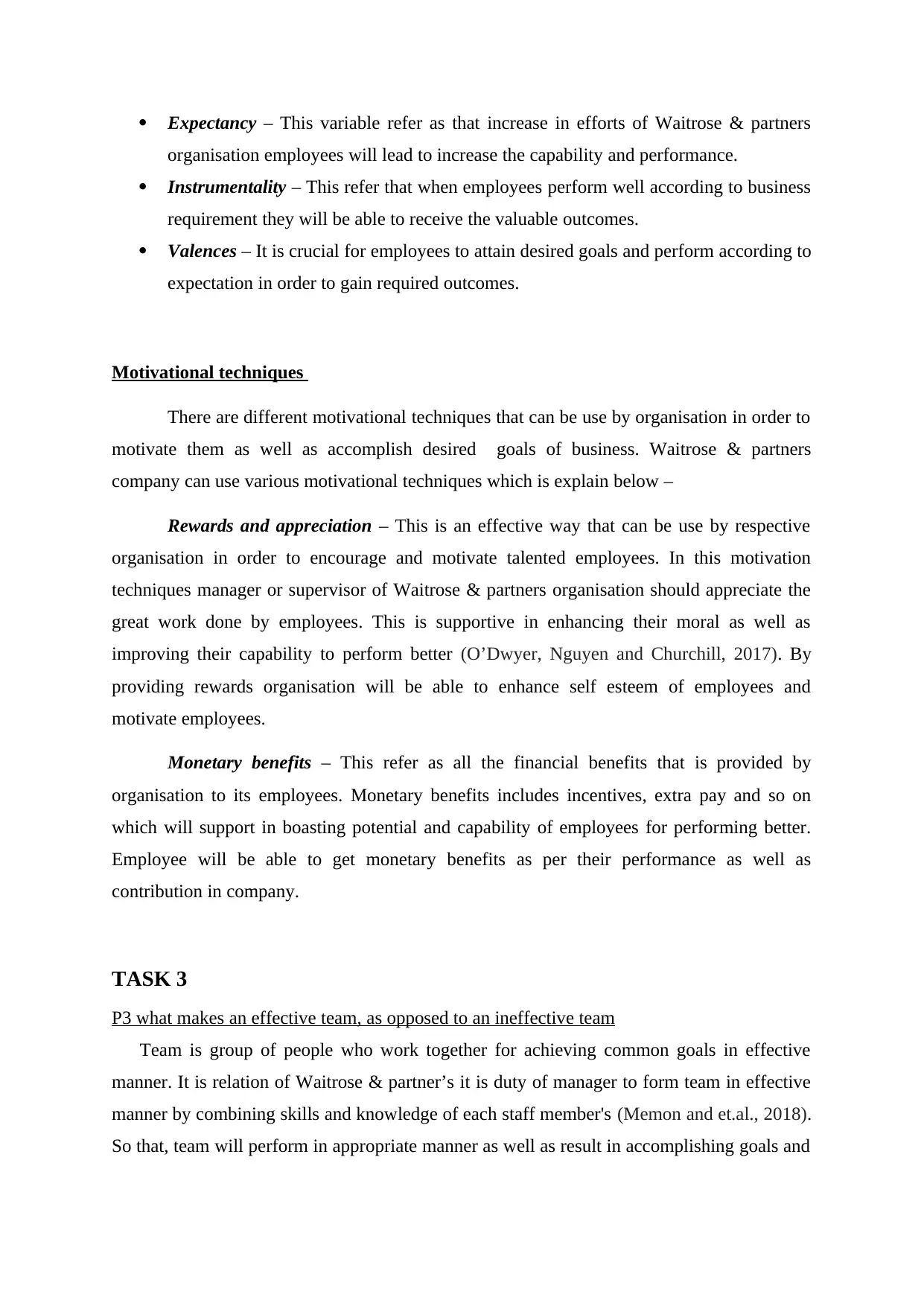
Expectancy – This variable refer as that increase in efforts of Waitrose & partners
organisation employees will lead to increase the capability and performance.
Instrumentality – This refer that when employees perform well according to business
requirement they will be able to receive the valuable outcomes.
Valences – It is crucial for employees to attain desired goals and perform according to
expectation in order to gain required outcomes.
Motivational techniques
There are different motivational techniques that can be use by organisation in order to
motivate them as well as accomplish desired goals of business. Waitrose & partners
company can use various motivational techniques which is explain below –
Rewards and appreciation – This is an effective way that can be use by respective
organisation in order to encourage and motivate talented employees. In this motivation
techniques manager or supervisor of Waitrose & partners organisation should appreciate the
great work done by employees. This is supportive in enhancing their moral as well as
improving their capability to perform better (O’Dwyer, Nguyen and Churchill, 2017). By
providing rewards organisation will be able to enhance self esteem of employees and
motivate employees.
Monetary benefits – This refer as all the financial benefits that is provided by
organisation to its employees. Monetary benefits includes incentives, extra pay and so on
which will support in boasting potential and capability of employees for performing better.
Employee will be able to get monetary benefits as per their performance as well as
contribution in company.
TASK 3
P3 what makes an effective team, as opposed to an ineffective team
Team is group of people who work together for achieving common goals in effective
manner. It is relation of Waitrose & partner’s it is duty of manager to form team in effective
manner by combining skills and knowledge of each staff member's (Memon and et.al., 2018).
So that, team will perform in appropriate manner as well as result in accomplishing goals and
organisation employees will lead to increase the capability and performance.
Instrumentality – This refer that when employees perform well according to business
requirement they will be able to receive the valuable outcomes.
Valences – It is crucial for employees to attain desired goals and perform according to
expectation in order to gain required outcomes.
Motivational techniques
There are different motivational techniques that can be use by organisation in order to
motivate them as well as accomplish desired goals of business. Waitrose & partners
company can use various motivational techniques which is explain below –
Rewards and appreciation – This is an effective way that can be use by respective
organisation in order to encourage and motivate talented employees. In this motivation
techniques manager or supervisor of Waitrose & partners organisation should appreciate the
great work done by employees. This is supportive in enhancing their moral as well as
improving their capability to perform better (O’Dwyer, Nguyen and Churchill, 2017). By
providing rewards organisation will be able to enhance self esteem of employees and
motivate employees.
Monetary benefits – This refer as all the financial benefits that is provided by
organisation to its employees. Monetary benefits includes incentives, extra pay and so on
which will support in boasting potential and capability of employees for performing better.
Employee will be able to get monetary benefits as per their performance as well as
contribution in company.
TASK 3
P3 what makes an effective team, as opposed to an ineffective team
Team is group of people who work together for achieving common goals in effective
manner. It is relation of Waitrose & partner’s it is duty of manager to form team in effective
manner by combining skills and knowledge of each staff member's (Memon and et.al., 2018).
So that, team will perform in appropriate manner as well as result in accomplishing goals and
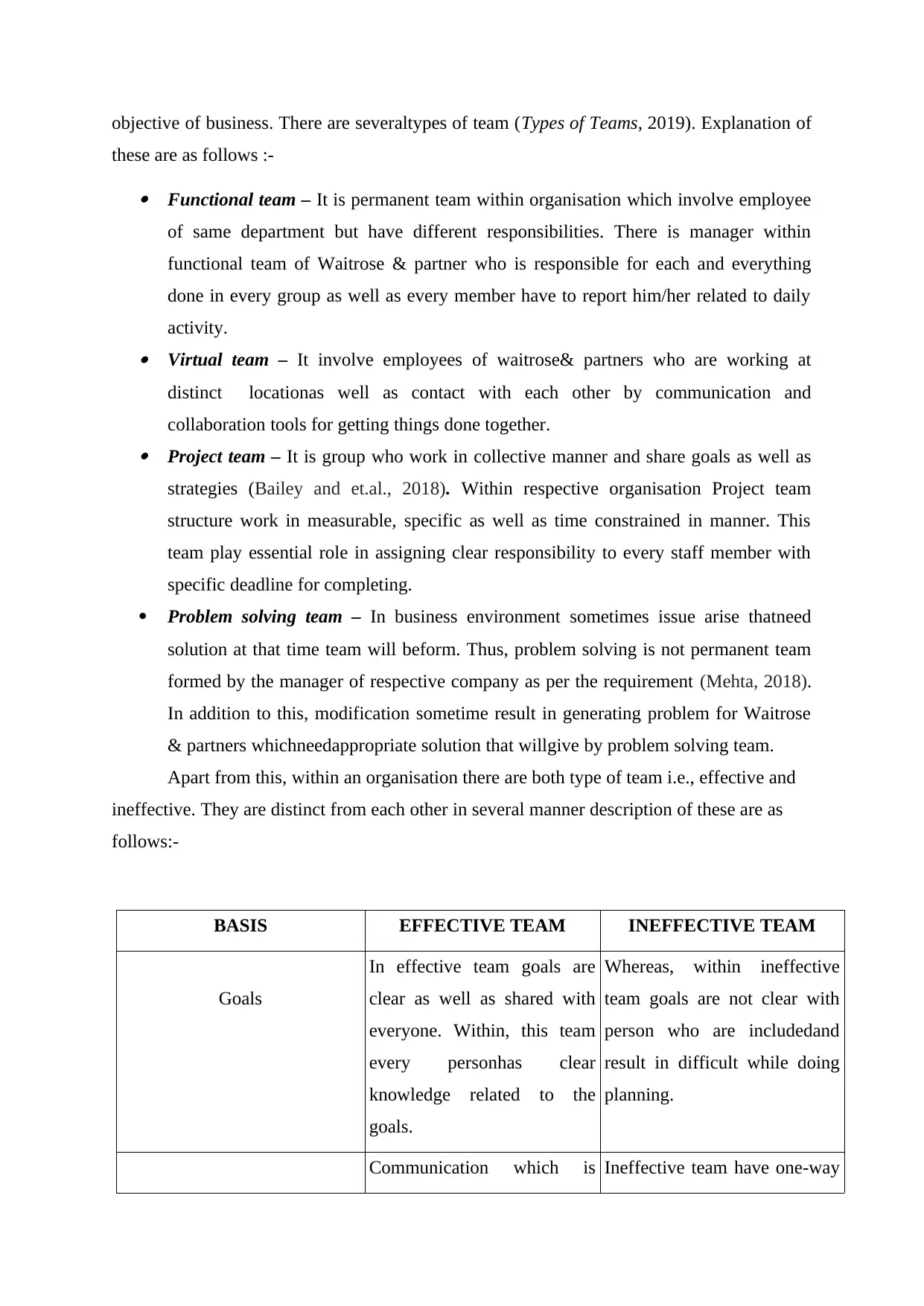
objective of business. There are severaltypes of team (Types of Teams, 2019). Explanation of
these are as follows :- Functional team – It is permanent team within organisation which involve employee
of same department but have different responsibilities. There is manager within
functional team of Waitrose & partner who is responsible for each and everything
done in every group as well as every member have to report him/her related to daily
activity. Virtual team – It involve employees of waitrose& partners who are working at
distinct locationas well as contact with each other by communication and
collaboration tools for getting things done together. Project team – It is group who work in collective manner and share goals as well as
strategies (Bailey and et.al., 2018). Within respective organisation Project team
structure work in measurable, specific as well as time constrained in manner. This
team play essential role in assigning clear responsibility to every staff member with
specific deadline for completing.
Problem solving team – In business environment sometimes issue arise thatneed
solution at that time team will beform. Thus, problem solving is not permanent team
formed by the manager of respective company as per the requirement (Mehta, 2018).
In addition to this, modification sometime result in generating problem for Waitrose
& partners whichneedappropriate solution that willgive by problem solving team.
Apart from this, within an organisation there are both type of team i.e., effective and
ineffective. They are distinct from each other in several manner description of these are as
follows:-
BASIS EFFECTIVE TEAM INEFFECTIVE TEAM
Goals
In effective team goals are
clear as well as shared with
everyone. Within, this team
every personhas clear
knowledge related to the
goals.
Whereas, within ineffective
team goals are not clear with
person who are includedand
result in difficult while doing
planning.
Communication which is Ineffective team have one-way
these are as follows :- Functional team – It is permanent team within organisation which involve employee
of same department but have different responsibilities. There is manager within
functional team of Waitrose & partner who is responsible for each and everything
done in every group as well as every member have to report him/her related to daily
activity. Virtual team – It involve employees of waitrose& partners who are working at
distinct locationas well as contact with each other by communication and
collaboration tools for getting things done together. Project team – It is group who work in collective manner and share goals as well as
strategies (Bailey and et.al., 2018). Within respective organisation Project team
structure work in measurable, specific as well as time constrained in manner. This
team play essential role in assigning clear responsibility to every staff member with
specific deadline for completing.
Problem solving team – In business environment sometimes issue arise thatneed
solution at that time team will beform. Thus, problem solving is not permanent team
formed by the manager of respective company as per the requirement (Mehta, 2018).
In addition to this, modification sometime result in generating problem for Waitrose
& partners whichneedappropriate solution that willgive by problem solving team.
Apart from this, within an organisation there are both type of team i.e., effective and
ineffective. They are distinct from each other in several manner description of these are as
follows:-
BASIS EFFECTIVE TEAM INEFFECTIVE TEAM
Goals
In effective team goals are
clear as well as shared with
everyone. Within, this team
every personhas clear
knowledge related to the
goals.
Whereas, within ineffective
team goals are not clear with
person who are includedand
result in difficult while doing
planning.
Communication which is Ineffective team have one-way
⊘ This is a preview!⊘
Do you want full access?
Subscribe today to unlock all pages.

Trusted by 1+ million students worldwide
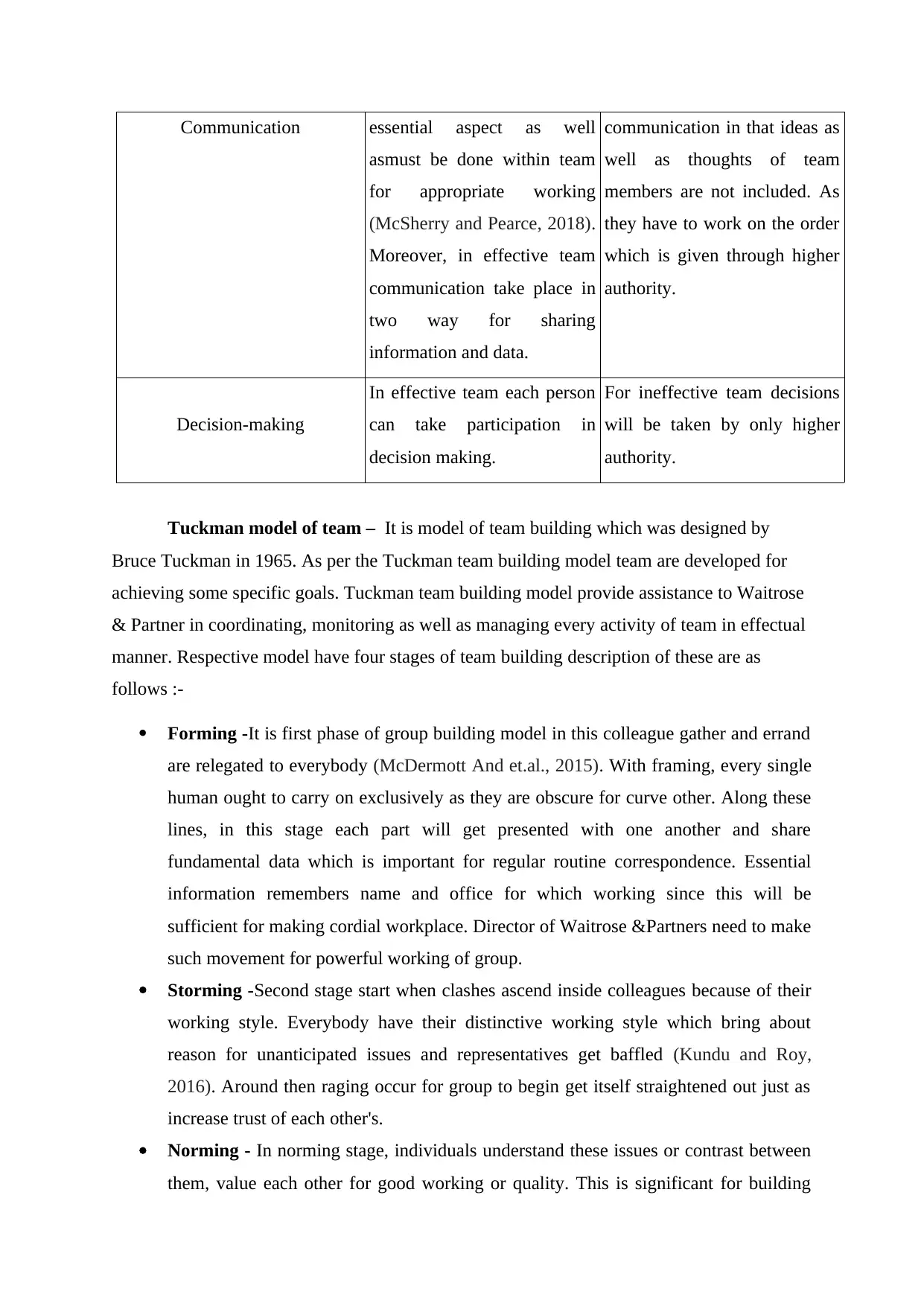
Communication essential aspect as well
asmust be done within team
for appropriate working
(McSherry and Pearce, 2018).
Moreover, in effective team
communication take place in
two way for sharing
information and data.
communication in that ideas as
well as thoughts of team
members are not included. As
they have to work on the order
which is given through higher
authority.
Decision-making
In effective team each person
can take participation in
decision making.
For ineffective team decisions
will be taken by only higher
authority.
Tuckman model of team – It is model of team building which was designed by
Bruce Tuckman in 1965. As per the Tuckman team building model team are developed for
achieving some specific goals. Tuckman team building model provide assistance to Waitrose
& Partner in coordinating, monitoring as well as managing every activity of team in effectual
manner. Respective model have four stages of team building description of these are as
follows :-
Forming -It is first phase of group building model in this colleague gather and errand
are relegated to everybody (McDermott And et.al., 2015). With framing, every single
human ought to carry on exclusively as they are obscure for curve other. Along these
lines, in this stage each part will get presented with one another and share
fundamental data which is important for regular routine correspondence. Essential
information remembers name and office for which working since this will be
sufficient for making cordial workplace. Director of Waitrose &Partners need to make
such movement for powerful working of group.
Storming -Second stage start when clashes ascend inside colleagues because of their
working style. Everybody have their distinctive working style which bring about
reason for unanticipated issues and representatives get baffled (Kundu and Roy,
2016). Around then raging occur for group to begin get itself straightened out just as
increase trust of each other's.
Norming - In norming stage, individuals understand these issues or contrast between
them, value each other for good working or quality. This is significant for building
asmust be done within team
for appropriate working
(McSherry and Pearce, 2018).
Moreover, in effective team
communication take place in
two way for sharing
information and data.
communication in that ideas as
well as thoughts of team
members are not included. As
they have to work on the order
which is given through higher
authority.
Decision-making
In effective team each person
can take participation in
decision making.
For ineffective team decisions
will be taken by only higher
authority.
Tuckman model of team – It is model of team building which was designed by
Bruce Tuckman in 1965. As per the Tuckman team building model team are developed for
achieving some specific goals. Tuckman team building model provide assistance to Waitrose
& Partner in coordinating, monitoring as well as managing every activity of team in effectual
manner. Respective model have four stages of team building description of these are as
follows :-
Forming -It is first phase of group building model in this colleague gather and errand
are relegated to everybody (McDermott And et.al., 2015). With framing, every single
human ought to carry on exclusively as they are obscure for curve other. Along these
lines, in this stage each part will get presented with one another and share
fundamental data which is important for regular routine correspondence. Essential
information remembers name and office for which working since this will be
sufficient for making cordial workplace. Director of Waitrose &Partners need to make
such movement for powerful working of group.
Storming -Second stage start when clashes ascend inside colleagues because of their
working style. Everybody have their distinctive working style which bring about
reason for unanticipated issues and representatives get baffled (Kundu and Roy,
2016). Around then raging occur for group to begin get itself straightened out just as
increase trust of each other's.
Norming - In norming stage, individuals understand these issues or contrast between
them, value each other for good working or quality. This is significant for building
Paraphrase This Document
Need a fresh take? Get an instant paraphrase of this document with our AI Paraphraser
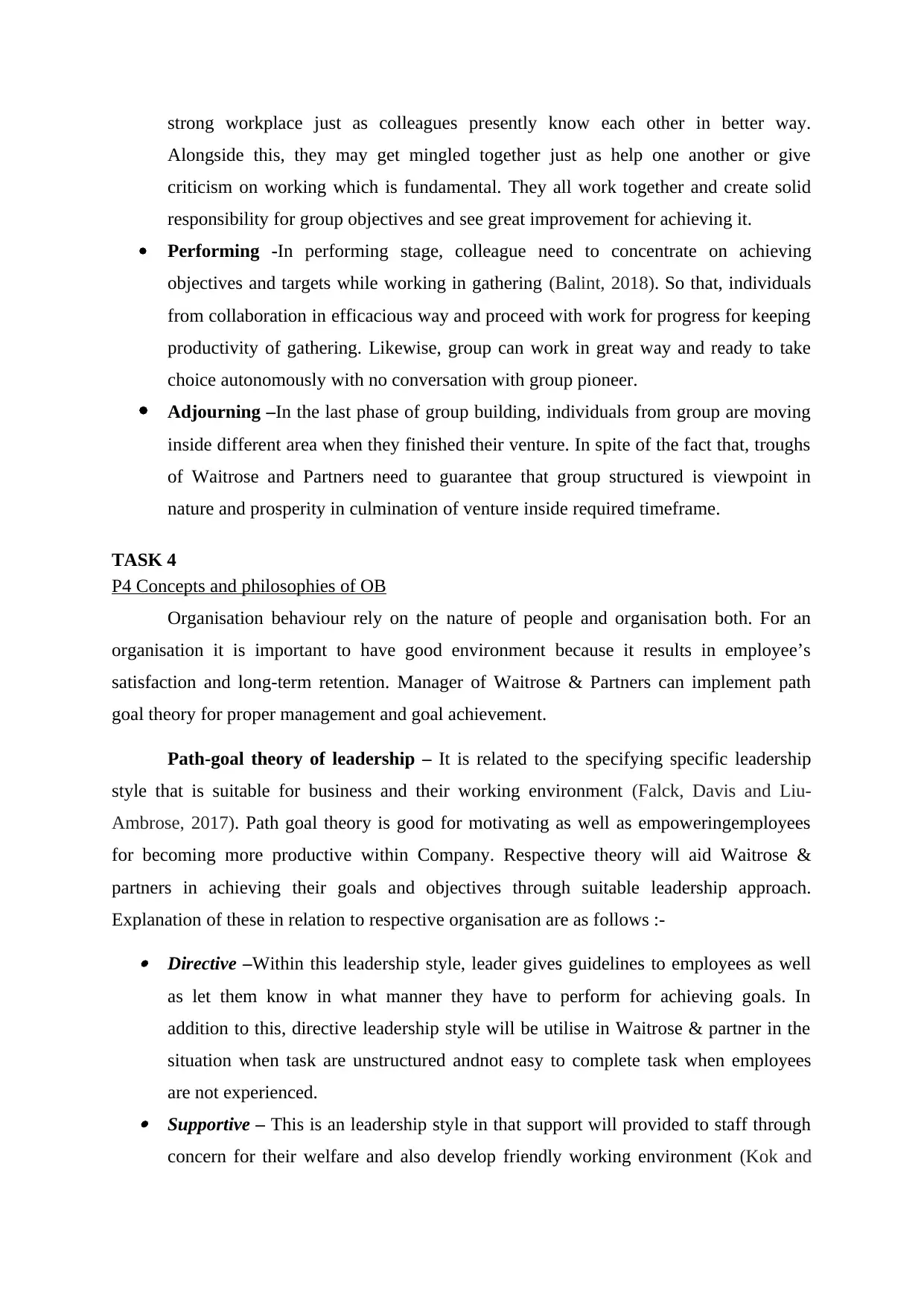
strong workplace just as colleagues presently know each other in better way.
Alongside this, they may get mingled together just as help one another or give
criticism on working which is fundamental. They all work together and create solid
responsibility for group objectives and see great improvement for achieving it.
Performing -In performing stage, colleague need to concentrate on achieving
objectives and targets while working in gathering (Balint, 2018). So that, individuals
from collaboration in efficacious way and proceed with work for progress for keeping
productivity of gathering. Likewise, group can work in great way and ready to take
choice autonomously with no conversation with group pioneer.
Adjourning –In the last phase of group building, individuals from group are moving
inside different area when they finished their venture. In spite of the fact that, troughs
of Waitrose and Partners need to guarantee that group structured is viewpoint in
nature and prosperity in culmination of venture inside required timeframe.
TASK 4
P4 Concepts and philosophies of OB
Organisation behaviour rely on the nature of people and organisation both. For an
organisation it is important to have good environment because it results in employee’s
satisfaction and long-term retention. Manager of Waitrose & Partners can implement path
goal theory for proper management and goal achievement.
Path-goal theory of leadership – It is related to the specifying specific leadership
style that is suitable for business and their working environment (Falck, Davis and Liu-
Ambrose, 2017). Path goal theory is good for motivating as well as empoweringemployees
for becoming more productive within Company. Respective theory will aid Waitrose &
partners in achieving their goals and objectives through suitable leadership approach.
Explanation of these in relation to respective organisation are as follows :- Directive –Within this leadership style, leader gives guidelines to employees as well
as let them know in what manner they have to perform for achieving goals. In
addition to this, directive leadership style will be utilise in Waitrose & partner in the
situation when task are unstructured andnot easy to complete task when employees
are not experienced. Supportive – This is an leadership style in that support will provided to staff through
concern for their welfare and also develop friendly working environment (Kok and
Alongside this, they may get mingled together just as help one another or give
criticism on working which is fundamental. They all work together and create solid
responsibility for group objectives and see great improvement for achieving it.
Performing -In performing stage, colleague need to concentrate on achieving
objectives and targets while working in gathering (Balint, 2018). So that, individuals
from collaboration in efficacious way and proceed with work for progress for keeping
productivity of gathering. Likewise, group can work in great way and ready to take
choice autonomously with no conversation with group pioneer.
Adjourning –In the last phase of group building, individuals from group are moving
inside different area when they finished their venture. In spite of the fact that, troughs
of Waitrose and Partners need to guarantee that group structured is viewpoint in
nature and prosperity in culmination of venture inside required timeframe.
TASK 4
P4 Concepts and philosophies of OB
Organisation behaviour rely on the nature of people and organisation both. For an
organisation it is important to have good environment because it results in employee’s
satisfaction and long-term retention. Manager of Waitrose & Partners can implement path
goal theory for proper management and goal achievement.
Path-goal theory of leadership – It is related to the specifying specific leadership
style that is suitable for business and their working environment (Falck, Davis and Liu-
Ambrose, 2017). Path goal theory is good for motivating as well as empoweringemployees
for becoming more productive within Company. Respective theory will aid Waitrose &
partners in achieving their goals and objectives through suitable leadership approach.
Explanation of these in relation to respective organisation are as follows :- Directive –Within this leadership style, leader gives guidelines to employees as well
as let them know in what manner they have to perform for achieving goals. In
addition to this, directive leadership style will be utilise in Waitrose & partner in the
situation when task are unstructured andnot easy to complete task when employees
are not experienced. Supportive – This is an leadership style in that support will provided to staff through
concern for their welfare and also develop friendly working environment (Kok and
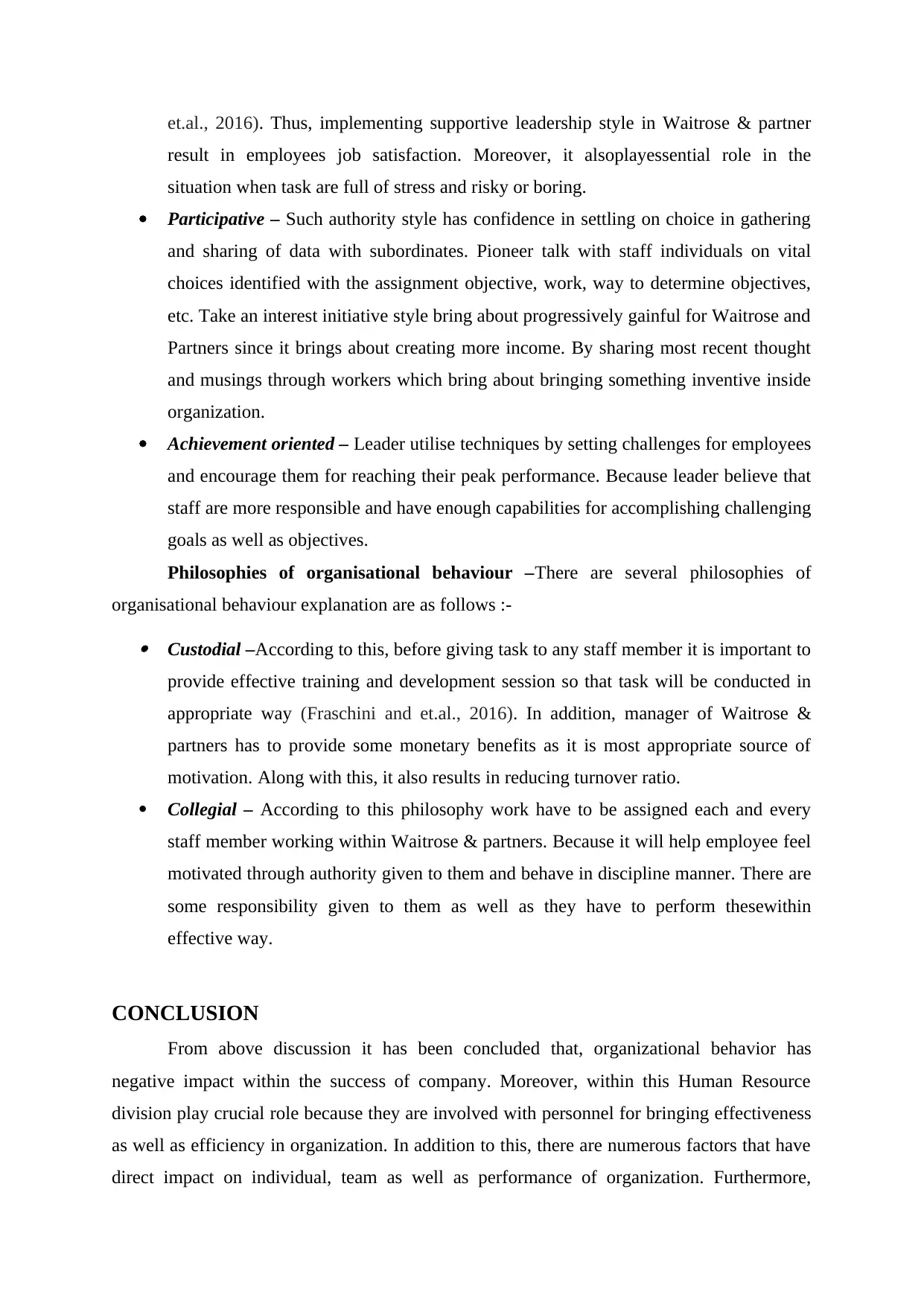
et.al., 2016). Thus, implementing supportive leadership style in Waitrose & partner
result in employees job satisfaction. Moreover, it alsoplayessential role in the
situation when task are full of stress and risky or boring.
Participative – Such authority style has confidence in settling on choice in gathering
and sharing of data with subordinates. Pioneer talk with staff individuals on vital
choices identified with the assignment objective, work, way to determine objectives,
etc. Take an interest initiative style bring about progressively gainful for Waitrose and
Partners since it brings about creating more income. By sharing most recent thought
and musings through workers which bring about bringing something inventive inside
organization.
Achievement oriented – Leader utilise techniques by setting challenges for employees
and encourage them for reaching their peak performance. Because leader believe that
staff are more responsible and have enough capabilities for accomplishing challenging
goals as well as objectives.
Philosophies of organisational behaviour –There are several philosophies of
organisational behaviour explanation are as follows :- Custodial –According to this, before giving task to any staff member it is important to
provide effective training and development session so that task will be conducted in
appropriate way (Fraschini and et.al., 2016). In addition, manager of Waitrose &
partners has to provide some monetary benefits as it is most appropriate source of
motivation. Along with this, it also results in reducing turnover ratio.
Collegial – According to this philosophy work have to be assigned each and every
staff member working within Waitrose & partners. Because it will help employee feel
motivated through authority given to them and behave in discipline manner. There are
some responsibility given to them as well as they have to perform thesewithin
effective way.
CONCLUSION
From above discussion it has been concluded that, organizational behavior has
negative impact within the success of company. Moreover, within this Human Resource
division play crucial role because they are involved with personnel for bringing effectiveness
as well as efficiency in organization. In addition to this, there are numerous factors that have
direct impact on individual, team as well as performance of organization. Furthermore,
result in employees job satisfaction. Moreover, it alsoplayessential role in the
situation when task are full of stress and risky or boring.
Participative – Such authority style has confidence in settling on choice in gathering
and sharing of data with subordinates. Pioneer talk with staff individuals on vital
choices identified with the assignment objective, work, way to determine objectives,
etc. Take an interest initiative style bring about progressively gainful for Waitrose and
Partners since it brings about creating more income. By sharing most recent thought
and musings through workers which bring about bringing something inventive inside
organization.
Achievement oriented – Leader utilise techniques by setting challenges for employees
and encourage them for reaching their peak performance. Because leader believe that
staff are more responsible and have enough capabilities for accomplishing challenging
goals as well as objectives.
Philosophies of organisational behaviour –There are several philosophies of
organisational behaviour explanation are as follows :- Custodial –According to this, before giving task to any staff member it is important to
provide effective training and development session so that task will be conducted in
appropriate way (Fraschini and et.al., 2016). In addition, manager of Waitrose &
partners has to provide some monetary benefits as it is most appropriate source of
motivation. Along with this, it also results in reducing turnover ratio.
Collegial – According to this philosophy work have to be assigned each and every
staff member working within Waitrose & partners. Because it will help employee feel
motivated through authority given to them and behave in discipline manner. There are
some responsibility given to them as well as they have to perform thesewithin
effective way.
CONCLUSION
From above discussion it has been concluded that, organizational behavior has
negative impact within the success of company. Moreover, within this Human Resource
division play crucial role because they are involved with personnel for bringing effectiveness
as well as efficiency in organization. In addition to this, there are numerous factors that have
direct impact on individual, team as well as performance of organization. Furthermore,
⊘ This is a preview!⊘
Do you want full access?
Subscribe today to unlock all pages.

Trusted by 1+ million students worldwide
1 out of 15
Related Documents
Your All-in-One AI-Powered Toolkit for Academic Success.
+13062052269
info@desklib.com
Available 24*7 on WhatsApp / Email
![[object Object]](/_next/static/media/star-bottom.7253800d.svg)
Unlock your academic potential
Copyright © 2020–2025 A2Z Services. All Rights Reserved. Developed and managed by ZUCOL.





